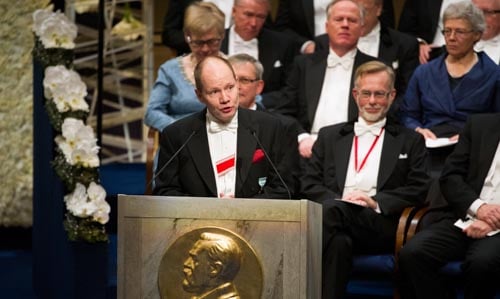Award ceremony speech
English
Presentation Speech by Professor Peter Englund, Permanent Secretary of the Swedish Academy, Secretary of the Nobel Committee for Literature, 10 December 2013.

Professor Peter Englund delivering the Presentation Speech for the 2013 Nobel Prize in Literature at the Stockholm Concert Hall.
Copyright © Nobel Media AB 2013
Photo: Alex Ljungdahl
Your Majesties, Your Royal Highnesses, Esteemed Laureates, Ladies and Gentlemen,
It may seem like a paradox, but it is actually quite logical: what we call world literature is generally rooted in the local and individual. In her writing, Alice Munro portrays with almost anthropological precision a recognisable, tranquil everyday world with predictable external accoutrements; her equivalent of William Faulkner’s Yoknapatawpha County is located in south-western Ontario. This flat Canadian agricultural landscape, with its broad rivers and seemingly bland small towns, is where most of her short stories unfold. But the serenity and simplicity are deceptive in every way.
The tranquillity of the outer world is always apparent in Alice Munro’s works, which then open the portals to an inner world where the opposite is true. Munro writes about what are usually called ordinary people, but her intelligence, compassion and astonishing power of perception enable her to give their lives a remarkable dignity – indeed redemption – since she shows how much of the extraordinary can fit into that jam-packed emptiness called The Ordinary. The trivial and trite are intertwined with the amazing and unfathomable – but never at the cost of contradiction. If you have never before fantasised about the strangers you see on a bus, you begin doing so after having read Alice Munro.
Her short stories rely very little on external drama. They are an emotional chamber play, a world of silences and lies, waiting and longing. The biggest events occur inside of her characters. The greatest pain remains unexpressed. Like few others, she is interested in the silent and the silenced, the passive, those who choose not to choose, who live on the sidelines, the quitters and losers. Barriers of gender and class are never far away in her works.
In the mental topography that is Munro’s own, what might have happened is often just as important as what actually happened. Of key importance are all the things her characters could not or did not wish to understand there and then, but that only long afterward stand revealed, at best in the form of an epiphany. She shows that our innermost self is essentially inaccessible to other people, often eluding even ourselves – until it is too late.
In an uncompromising way, Alice Munro demonstrates that love rarely saves us or leads to reliable happiness, and that few things can be as devastating to us as our own dreams. Sexuality is constantly present and its power is gripping, but often blind and even devastating. Even though genuine happiness may occur, sometimes accidentally, people rarely go unpunished for believing in romantic love. This might seem unbearably dark, or even painful, if her piercing lucidity were not mixed with something that – for want of a better word – I must call tenderness. If you read a lot of Alice Munro’s works carefully, sooner or later, in one of her short stories, you will come face to face with yourself; this is an encounter that always leaves you shaken and often changed, but never crushed.
The seemingly prosaic surface level in Alice Munro’s short stories is interwoven in an interesting way with her writing style and distinctive storytelling technique. The minimalist style we encounter is clean, transparent, subtle and stunningly precise. It is a challenge to find an unessential word or a superfluous phrase. Reading one of her texts is like watching a cat walk across a laid dinner table. A brief short story can often cover decades, summarising a life, as she moves deftly between different periods. No wonder Alice Munro is often able to say more in 30 pages than an ordinary novelist is capable of in 300. She is a virtuoso of the elliptical and – as the Academy said in its brief prize citation – the master of the contemporary short story.
Over the years, numerous prominent scientists have received their well-deserved reward in this auditorium for having solved some of the great enigmas of the universe or of our material existence. But you, Alice Munro, like few others, have come close to solving the greatest mystery of them all: the human heart and its caprices.
The Swedish Academy congratulates you. I now ask Jenny Munro to rise and, in her mother’s place, receive the 2013 Nobel Prize in Literature from the hand of His Majesty the King.
Nobel Prizes and laureates
Six prizes were awarded for achievements that have conferred the greatest benefit to humankind. The 12 laureates' work and discoveries range from proteins' structures and machine learning to fighting for a world free of nuclear weapons.
See them all presented here.
